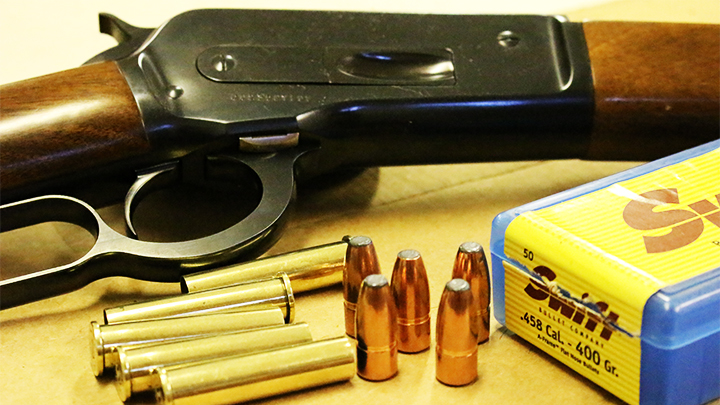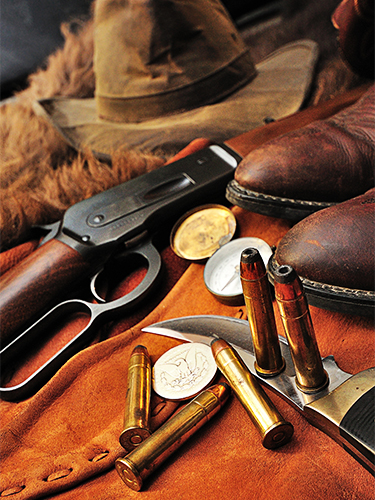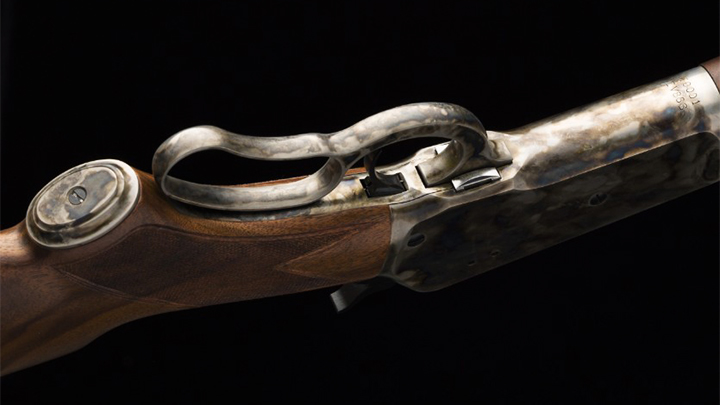
We had been stalking the herd for the better part of the morning, when we finally saw the bull come wide to the left side of the herd. My father brought his rifle to shoulder, and sent a 400-grain Swift A-Frame into the base of the bull’s neck, precisely where the guide instructed, dropping the beast where it stood.
His smile was equally inspired by the bison he stood over—we were hunting the quarter-million-acre Triple U Ranch in South Dakota, where “Dances with Wolves” was filmed—and by one of his favorite rifles: a Browning Model 1886 in .45-70 Government.

That rifle Dad carried was released in 1986, as a centennial celebration of the release of one of John Browning’s finest designs, and one of the strongest lever-action rifles ever developed.
The Model 1886 was much stronger than the Model 1873 or Model 1876, using two vertical steel bars to keep that action closed and the bolt firmly in place; the receiver was also different in that it was long enough to handle the popular and plentiful .45-70 Government cartridge, among other powerful blackpowder cartridges like the .50-110 WCF, .45-90 (albeit with shorter bullets) and .40-82 WCF. Browning’s beefy lever gun would also prove to be strong enough to survive the transition to smokeless powder when fitted with a nickel-steel barrel, being chambered for the .33 Winchester in 1903. It was even chambered for the 32-gauge shotshell, available as a custom order.

In production from 1886 until 1935, the Winchester Model 1886 has that inimitable feel to its action; just working the lever gives the user an idea of its strength. The ’86 action locks up like a bank vault, and that strong action allowed me to handload those 400-grain A-Frames—seated over a healthy charge of Hodgdon’s BL-C(2)—to a muzzle velocity of just over 1800 fps from his 26-inch octagon barrel. Mind you, that is from a modern rifle, but it is indicative of the strength of the 1886.
A buckhorn rear sight, with a serrated elevator for vertical adjustments, could be drifted in its slot for windage adjustments, and the rifle was produced with a variety of front sights over the years of production. A tubular magazine—both full-length and half-length magazines were available—sits underneath the barrel, and is fed through a loading port on the right side of receiver.

The 1886 was available with a single trigger, though a double-set trigger was available. A two-piece walnut stock—predominately straight-gripped though also made with a curved pistol grip—rounded out the furniture, and was generally plain, except for the Sporting Deluxe variant, which was checkered front and rear. Some models had a straight shotgun butt, and others a curved steel buttplate. Like so many of John M. Browning’s other designs, the simplicity is a part of the elegance. There are some neat takedown models in both half- and full-magazines.
The 1886 was discontinued in 1935, when it was replaced by the Model 71 Winchester—itself based strongly on the 1886 action—chambered in the powerful .348 Winchester. While there is no denying the success of the Model 71, which was designed to be the premier lever-action rifle, like its bolt-action counterpart the Model 70, there is also no denying the importance of the 1886 in the progression of repeating rifles.
Browning released a pair of commemorative rifles in 1986; Dad bought the standard grade with blued metalwork and plain stock, and there was a High Grade version as well with a nickel-plated engraved receiver and checkered stock. Both were chambered in .45-70 Government.

Thankfully, Winchester has re-introduced the 1886 to its lineup, in several variations. There is the Model 1886 Deluxe Case Hardened comes with a curved pistol grip, checkered stock and case-hardened appointments and a 24-inch octagonal stock, chambered in .45-70 Government. The Model 1886 Deluxe has a similar conformation to the Case Hardened variant, except that it is available in .45-70 and .45-90, a new option for 2020. They share that classic crescent steel buttplate, which digs into your shoulder, but hey, that just comes with the territory.
The new Winchesters aren’t true replicas or reissues; they do have the tang safety common to the newer model Winchesters. But, they offer the 1886 experience to a whole new generation of shooters and hunters, with modern metallurgy, in a rifle capable of handling the modern, stout .45-70 loads like the Hornady 325-grain LeveRevolution at 2050 fps and the Buffalo Bore 400-grain load at 2000 fps.
There are so many excellent lever-action rifles to choose from, including the classic Model 1894 Winchester, the Model 1893 Marlin and Model 1892 Winchester, up through the more modern designs like the Marlin 336 and Winchester Model 88, to the Browning BLR, but to me, the 1886 Winchester remains at the top of the heap.
It is heavier than some of the other designs, but I like the heft and balance of the 1886. It settles down well for the shot, and even the heavier .45-70 loads are tolerable, though the points of that crescent buttplate can and will bruise your shoulder when shooting from the bench.

Whether new or vintage, having a Model 1886 in your safe is never a bad idea, and it makes a great choice for nearly any big game at ranges suitable for the big rimmed cartridges. I still enjoy shooting Dad’s Browning—now almost 35 years old—and enjoy his smile when he shoots it. I’m still on the hunt for an ’86 of my own, probably a vintage takedown, but who knows; there are so many cool variations one never knows what can be found in an old gun shop.